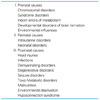References
1. Weeber EJ, Levenson JM, Sweatt JD. Molecular genetics of human cognition. Mol Interv 2002. 2376–391.
2. Schalock RL, Luckasson RA, Shogren KA, Borthwick-Duffy S, Bradley V, Buntinx WH, Coulter DL, Craig EM, Gomez SC, Lachapelle Y, Reeve A, Snell ME, Spreat S, Tassé MJ, Thompson JR, Verdugo MA, Wehmeyer ML, Yeager MH. The renaming of mental retardation: understanding the change to the term intellectual disability. Intellect Dev Disabil 2007. 45116–124.
3. American Psychiatric Association. Task Force on DSM-IV. Diagnostic and statistical manual of mental disorders: DSM-IV-TR 2000. 4th edth ed. Washington, DC: American Psychiatric Association; 41–48.
4. Harris JC. In : Harris JC, ed. The classification of intellectual disability. Intellectual disability: understanding its development, causes, classification, evaluation, and treatment 2006. 1st edth ed. New York: Oxford University Press; 42–78.
5. American Association on Mental Retardation. Mental retardation: definition, classification, and systems of supports 2002. 10th edth ed. Washington, D.C.: American Association on Mental Retardation; 3–48.
6. Curry CJ, Stevenson RE, Aughton D, Byrne J, Carey JC, Cassidy S, Cunniff C, Graham JM Jr, Jones MC, Kaback MM, Moeschler J, Schaefer GB, Schwartz S, Tarleton J, Opitz J. Evaluation of mental retardation: recom-mendations of a Consensus Conference: American College of Medical Genetics. Am J Med Genet 1997. 72468–477.
7. Accardo PJ, Capute AJ. In : Capute AJ, Accardo PJ, eds. Developmental disabilities in infancy and childhood 1996. 2nd edth ed. Baltimore: P.H. Brookes Pub. Co.; 211–219.
8. Moeschler JB, Shevell M. Clinical genetic evaluation of the child with mental retardation or developmental delays. Pediatrics 2006. 1172304–2316.
9. Moeschler JB. Genetic evaluation of intellectual disabilities. Semin Pediatr Neurol 2008. 152–9.
10. Battaglia A, Carey JC. Diagnostic evaluation of developmental delay/mental retardation: An overview. Am J Med Genet C Semin Med Genet 2003. 117C3–14.
11. Shevell M, Ashwal S, Donley D, Flint J, Gingold M, Hirtz D, Majnemer A, Noetzel M, Sheth RD. Practice parameter: Evaluation of the child with global developmental delay: Report of the Quality Standards Subcommittee of the American Academy of Neurology and the Practice Committee of the Child Neurology Society. Neurology 2003. 60367–380.
12. Battaglia A. Neuroimaging studies in the evaluation of developmental delay/mental retardation. Am J Med Genet C Semin Med Genet 2003. 117C25–30.
13. Bianchi MC, Tosetti M, Fornai F, Alessandri MG, Cipriani P, De Vito G, Canapicchi R. Reversible brain creatine deficiency in two sisters with normal blood creatine level. Ann Neurol 2000. 47511–513.
14. Salomons GS, van Dooren SJ, Verhoeven NM, Cecil KM, Ball WS, Degrauw TJ, Jakobs C. X-linked creatine-transporter gene (SLC6A8) defect: a new creatine-deficiency syndrome. Am J Hum Genet 2001. 681497–1500.
15. Harris JC. In : Harris JC, ed. Epidemiology: Who is affected? Intellectual disability: understanding its development, causes, classification, evaluation, and treatment 2006. 1st edth ed. New York: Oxford University Press; 42–78.
16. Harris JC. In : Harris JC, ed. Origins, changing concepts, and legal safeguards. Intellectual disability: understanding its development, causes, classification, evaluation, and treatment 2006. 1st edth ed. New York: Oxford University Press; 11–41.
17. Johnson CP, Walker WO Jr, Palomo-Gonźalez SA, Curry CJ. Mental retardation: diagnosis, management, and family support. Curr Probl Pediatr Adolesc Health Care 2006. 36126–165.
18. American Academy of Pediatrics. Health supervision for children with Down syndrome. Pediatrics 2001. 107442–449.
19. American Academy of Pediatrics. Health care supervision for children with Williams syndrome. Pediatrics 2001. 1071192–1204.
20. McEwen IR, Hansen LH. In : Campbell SK, Vander Linden DW, Palisano RJ, eds. Children with motor and cognitive impairment. Physical therapy for children 2006. Missouri: Sounders Elsevier; 591–624.
21. Marshall D, McConkey R, Moore G. Obesity in people with intellectual disabilities: the impact of nurse-led health screenings and health promotion activities. J Adv Nurs 2003. 41147–153.
22. van der Putten A, Vlaskamp C, Reynders K, Nakken H. Children with profound intellectual and multiple disabilities: the effects of functional movement activities. Clin Rehabil 2005. 19613–620.
23. Bluechardt MH, Wiener J, Shephard RJ. Exercise programmes in the treatment of children with learning disabilities. Sports Med 1995. 1955–72.
24. Huttenlocher PR, Dabholkar AS. Regional differences in synaptogenesis in human cerebral cortex. J Comp Neurol 1997. 387167–178.
25. Ramey CT, Ramey SL. Prevention of intellectual disabilities: early interventions to improve cognitive development. Prev Med 1998. 27224–232.
26. Ramey CT, Campbell FA. Preventive education for high-risk children: cognitive consequences of the Carolina Abecedarian Project. Am J Ment Defic 1984. 88515–523.
27. Wasik BH, Ramey CT, Bryant DM, Sparling JJ. A longitudinal study of two early intervention strategies: Project CARE. Child Dev 1990. 611682–1696.
28. Ramey CT, Bryant DM, Wasik BH, Sparling JJ, Fendt KH, LaVange LM. Infant Health and Development Program for low birth weight, premature infants: program elements, family participation, and child intelligence. Pediatrics 1992. 89454–456.
